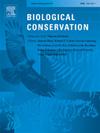Optimizing demographic analysis in the face of missing data years to improve conservation of threatened species
IF 4.9
1区 环境科学与生态学
Q1 BIODIVERSITY CONSERVATION
引用次数: 0
Abstract
Quantification of population dynamics and predictions of species viability rely on estimates of vital rates and an understanding of the ecological drivers of these rates. Most standard methods for assessing impacts of drivers, such as climate, on vital rates require annual demographic data for many individuals over multiple years. However, many real studies have either planned or unplanned data gaps. Vital rates are usually estimated over annual transitions, therefore one year of missing data results in two missing estimates. Additionally, relating annual climate variation to changes in vital rates is challenging if studies do not collect data annually. To avoid this loss of information due to missing data, we developed and then tested a Bayesian modeling approach for a dataset with missing years. Using an 18-year study of the rare plant Eriogonum brandegeei we estimate vital rates, their relationship to annual climate, and stochastic population growth. By comparing model performance across data subsets, as well as in tests using simulated data, we find that the approach works well with missing years of demographic data and removes the need to ignore information from multi-year transitions. This generalizable approach increases the useability of available data to study species dynamics despite patchy demographic data.
面对数据缺失年优化人口分析,改善受威胁物种的保护工作
种群动态的量化和物种生存能力的预测依赖于对生命率的估计和对这些生命率的生态驱动因素的了解。评估气候等驱动因素对生命率影响的大多数标准方法都需要许多个体多年的年度人口统计数据。然而,许多实际研究都存在计划内或计划外的数据缺口。生命率通常是通过年度转换来估算的,因此一年的数据缺失会导致两个估算值的缺失。此外,如果研究不是每年收集数据,将年度气候变异与生命率变化联系起来就具有挑战性。为了避免因数据缺失而造成的信息损失,我们开发了一种贝叶斯建模方法,并对缺失年份的数据集进行了测试。我们利用对稀有植物 Eriogonum brandegeei 长达 18 年的研究,估算了其生命率、生命率与年度气候的关系以及随机种群增长。通过比较不同数据子集的模型性能,以及使用模拟数据进行的测试,我们发现该方法在人口数据缺失年份也能很好地发挥作用,而且无需忽略多年过渡信息。这种可推广的方法提高了可用数据的利用率,从而可以在人口数据不完整的情况下研究物种动态。
本文章由计算机程序翻译,如有差异,请以英文原文为准。
求助全文
约1分钟内获得全文
求助全文
来源期刊

Biological Conservation
环境科学-环境科学
CiteScore
10.20
自引率
3.40%
发文量
295
审稿时长
61 days
期刊介绍:
Biological Conservation is an international leading journal in the discipline of conservation biology. The journal publishes articles spanning a diverse range of fields that contribute to the biological, sociological, and economic dimensions of conservation and natural resource management. The primary aim of Biological Conservation is the publication of high-quality papers that advance the science and practice of conservation, or which demonstrate the application of conservation principles for natural resource management and policy. Therefore it will be of interest to a broad international readership.
 求助内容:
求助内容: 应助结果提醒方式:
应助结果提醒方式:


